Interview with Bosch and VdS on the Certification for Video Fire Detection Products
The VdS, a German certification body, has developed a demanding test procedure for video-based fire detection software e.g. as the new Bosch Aviotec, incorporating the established ...


The VdS, a German certification body, has developed a demanding test procedure for video-based fire detection software e.g. as the new Bosch Aviotec, incorporating the established VdS 2203 guidelines.
At Intersec 2018, Dr. Heiko Baumgartner and Lisa Schneiderheinze of GIT SECURITY had the chance to bring both parties to one table and talk to Dhaval Shah, Regional Product Marketing Manager for Fire Alarm and Intrusion Systems at Bosch, to Stefan Kratzmeir, Head of International Market Development Fire Protection at VdS and to Ulrich Rabe, Head of Customer Service Fire Detection Systems at VdS.
GIT SECURITY: Mr. Rabe, could you tell us a bit how VdS gets approached for projects like this and how you proceed from the start to the final certification?
Ulrich Rabe: Normally, we get a request from a customer like Bosch, if everything starts with an idea on the customer side. The whole project gets then delivered to the laboratory where we develop a frame test program. This can be understood as laying ground rules for testing. Sometimes there are no standards for a certain product or technology. Then we need to find out if there is anything comparable in the field, or we can develop new test procedures for it. For Bosch’s video-based fire detection software, for example, the tests were out of range of EN54. Based on this, we had to develop a guideline that might also act as a base for an international standard. In general, after going through a lot of thorough testing procedures we then release a proposal for an independent standard. Very often this is much appreciated by engineers in the field. We create a state of the art guideline.
Stefan Kratzmeir: If you look at it from an international perspective there are a lot of challenges outside Europe. The product certification is different in Europe, the Middle East, and the US. We do always compare the specifications in the various countries and try to communicate with the authorities. The situation at the start was the following: EN 54 did not include any standards governing video-based fire detection. ISO has published a technical specification, but this is not binding and many experts consider it to be incomplete. North America has progressed one stage further: there, video-based fire detection can be certified in accordance with FM3232 and UL268B. But this is of course not accepted within Europe and other countries.
Why is a certification so challenging in this topic?
Ulrich Rabe: In case of fire detection in general, there is one ground rule: Fire detectors have to be reliable. So, video fire detection has to detect smoke and flames at any time, even in dusty environments. It was a big challenge to combine the super-fast detection capability with a highly reliable alarm. But reliable detection is not the only criteria. Reliable detection needs to be paired with a very low false alarm rate. If there are too many false alarms, people don’t trust the system anymore. We tested forth and back many times in our laboratories before we had a test procedure that products complying with it met both criteria.
Dhaval Shah: Niche applications are always linked to a high-risk potential and they are simply expected to work. We as a manufacturer need to look for the highest quality in that area. High-end niche applications are not price-driven, but high standards for developing a high-quality product are involved since we needed to detect fires at an early stage. There are no fines or penalties for a false alarm in fire detection but you need to limit false alarms to the absolute minimum.
Mr. Shah, what was Bosch’s motivation to have a trusted certification for the product? And at what stage of product development was VdS involved in testing?
Dhaval Shah: Without a certification from a trusted certification body you have little chance to introduce a product in highly regulated markets like the fire safety industry. This is why we turned to VdS as they have the expertise and experience in a lot of countries and are a trusted partner for a lot of authorities. We are video experts and we wanted to use our deep knowledge to develop something for the fire Industry, a very conservative and regulated industry. We developed many beta versions and pre-releases before we finally gave it to the hands of VdS to co-develop the tests together with us and to get the feedback to improve the product. We started working with VdS when we were convinced that this product is going to work. We wanted someone we could trust to give our product to.
Stefan Kratzmeir: Right from the beginning when Bosch approached us we were more than happy to do the project as it really is a product out of the normal scope. No traditional detector can detect smoke and flames at the same time. For a project like this trust is the key. You need people to trust and people who trust you that it works, and then you can really move something.
Certification processes are not considered to be the fastest in the world. When did you approach VdS and how long did the whole project take?
Ulrich Rabe: Bosch applied for testing in November 2016. And the whole testing period lasted for a good year. So, it was a very good project from our point of view also having in mind that new test procedures had to be developed.
What is the result?
Stefan Kratzmeir: Finally we have developed a demanding test procedure for Aviotec starlight 8000, incorporating the established VdS 2203 guidelines, “Requirements of fire protection software” and the “Specifications for the testing of flame detectors”, and it has been certified under the reference G217090. This serves to underline the quality of the product since it has complied with our stringent testing requirements for safe and speedy detection of test fires. Aviotec IP starlight 8000 is, therefore, the first system worldwide to hold a VdS certification as an “automatic video camera for visual monitoring of fires, which is used for the purpose of visually verifying fire events”.
Can you give us a little more background on the application side of the analytics software?
Dhaval Shah: The design software is very open since it must fit into a VMS (video management system) and other management platforms. We wanted that the whole system is able to work together seamlessly at all components. Our analytical software uses algorithms for both, the detection of smoke and the detection of flames. In order to detect smoke quickly and efficiently, Aviotec’s algorithms use a physical smoke model to detect smoke rising directly from the source. This model is based on the shape assumed by smoke as it rises and loses density and its characteristic pattern of movement, amongst other information. The algorithms are able to draw a reliable distinction between smoke and moving objects. They detect smoke haze levels as low as 30 percent, whereas most video-based solutions require levels of 50-65 percent. Flame detection uses a physical flame model, based on factors such as flame color, flicker, and shape. The flame characteristics of various fires have been comprehensively analysed to make intelligent video analysis just as reliable as the smoke detection.
Business Partner
VdS Schadenverhütung GmbH - ArchiveAmsterdamer Str. 174
50735 Köln
Germany
most read


The Benefits of AI-based Video Surveillance Solutions for Sports Venues
Dallmeier Interview: Artificial intelligence Makes Stadiums Smarter

Is Your Venue Ready for Martyn’s Law?
Martyn’s Law demands stronger security by 2027. Is your venue prepared to protect and respond?


Security management, building security & perimeter protection: the winners of category E at the GIT SECURITY AWARD 2026
GIT SECURITY AWARD 2026: Security management, building security & perimeter protection - an overview of the most innovative solutions







